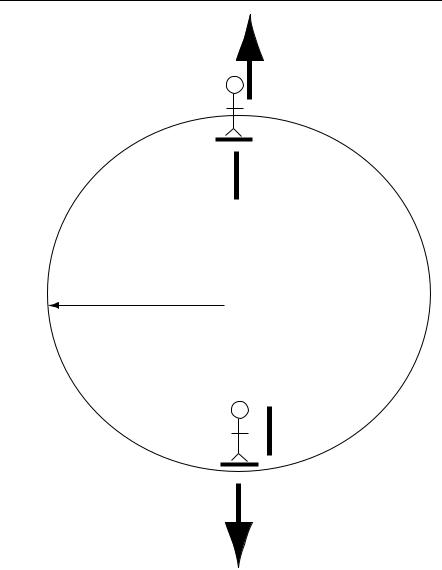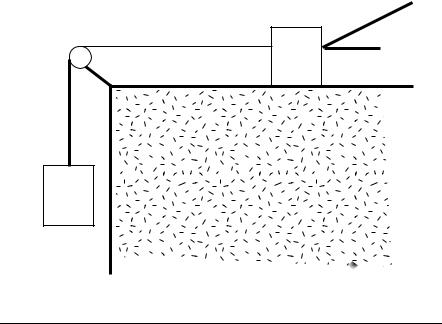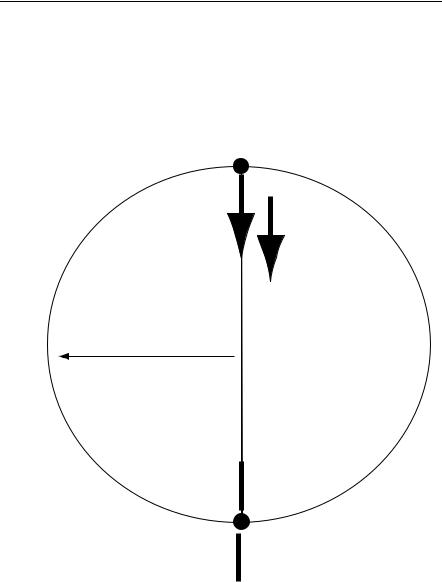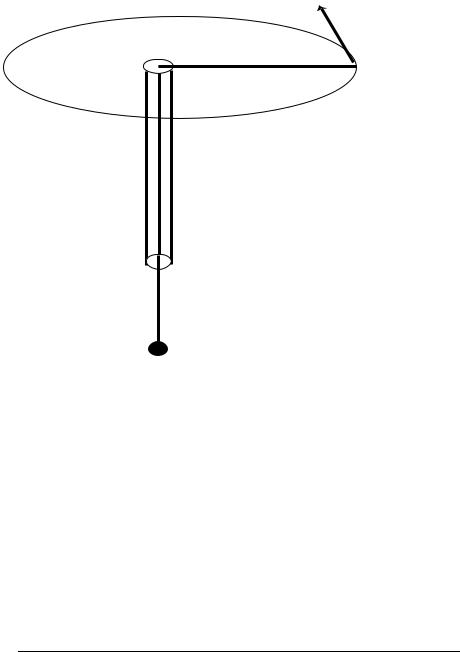
Solutions manual for mechanics and thermodynamics
.pdf
41
3.A ferris wheel rotates at constant speed in a vertical circle of radius R and it takes time T to complete each circle. Derive a formula, in terms of m, g, R, T , for the weight that a passenger of mass m feels at the top and bottom of the circle. Comment on whether your answers make sense. (Hint: the weight that a passenger feels is just the normal force.)
SOLUTION
N
 W
W
R
 N
N
W
42 |
|
|
|
|
|
|
|
|
|
|
CHAPTER 5. |
FORCE & MOTION - II |
|
|
|||||||||
Bottom: |
|
|
|
Top: |
|
|
|
|
|
|
|
|
|||||||||||
|
|
|
|
|
|
|
|
|
|
|
|
|
|
|
|
|
|
|
|
|
|
||
ßFy = may |
|
|
ßFy = may |
|
|
|
|
|
|
|
|
||||||||||||
|
|
mv2 |
|
|
|
|
|
|
mv2 |
|
|
|
|||||||||||
N ° W = |
|
|
|
|
|
|
|
|
N ° W = ° |
|
|
|
|
|
|
|
|
||||||
|
|
R |
|
|
|
R |
|
|
|
||||||||||||||
The weight you feel is just N. |
|
|
|
|
|
|
|
|
|
|
|
|
|||||||||||
N = W + |
mv2 |
|
|
|
|
|
|
mv2 |
|
|
|
|
|
|
|
|
|||||||
|
|
|
|
|
|
|
|
|
|
|
N = W ° |
|
|
|
|
|
|
|
|
|
|||
|
R |
µ |
T |
|
|
R |
|
|
|
|
|
T |
|
|
|||||||||
= mg + R |
|
|
|
= mg ° R µ |
|
||||||||||||||||||
|
|
m |
|
|
|
2ºR |
|
2 |
|
|
|
|
|
|
m |
2ºR |
|
2 |
|||||
= mg + m |
4º2R |
|
|
|
= mg ° m |
|
4º2R |
|
|
|
|
||||||||||||
|
T 2 |
|
|
|
T 2 |
|
|
|
|||||||||||||||
At the bottom the person feels heavier and at the top the person feels lighter, which is as experience shows !

43
4.A block of mass m1 on a rough, horizontal surface is connected to a second mass m2 by a light cord over a light frictionless pulley as shown in the Øgure. (`Light' means that we can neglect the mass of the cord and the mass of the pulley.) A force of magnitude F is applied to the mass m1 as shown, such that m1 moves to the right. The coe±cient of kinetic friction between m1 and the surface is . Derive a formula for the acceleration of the masses. [Serway 5th ed., pg.135, Fig 5.14]
 F
F
θ
m1
m2
SOLUTION
Let the acceleration of both masses be a. For mass m2 (choosing m2a with the same sign as T ):
T° W2 = m2a
T= m2a + m2g
For mass m1: |
|
TX F |
|
|
X |
|
|
|
|
F cos µ |
|
|
|
|
|
|
|
||
|
° |
Fx = m1a |
Fy = 0 |
° |
|
|
|
||
|
° k |
1 |
a |
N + F sin µ |
W |
1 |
= 0 |
||
|
|
|
= m |
|
|
||||
F cos µ ° T ° N = m1a |
N = m1g ° F sin µ |
||||||||

44 |
CHAPTER 5. FORCE & MOTION - II |
Substitute for T and N into the left equation
Fcos µ ° m2a ° m2g ° (m1g ° F sin µ) = m1a
F(cos µ + sin µ) ° g(m2 + m1) = m1a + m2a
a = F (cos µ + sin µ) ° g(m2 + m1) m1 + m2

45
5.If you whirl an object of mass m at the end of a string in a vertical circle of radius R at constant speed v, derive a formula for the tension in the string at the top and bottom of the circle.
SOLUTION
T
W
R
 T
T
 W
W

46
Bottom:
ßFy = |
may |
|||||||
T ° W |
= |
mv2 |
||||||
|
R |
|
||||||
T |
= |
W + |
mv2 |
|
||||
|
R |
|||||||
|
|
|
|
|
|
|||
T |
= |
mg + |
mv2 |
|||||
R |
||||||||
|
|
|
|
|
|
|||
CHAPTER 5. FORCE & MOTION - II
Top:
ßFy = may
T + W = mvR2
T = mvR2 ° W T = mvR2 ° mg

47
6.Two masses m1 and m2 are connected by a string passing through a hollow pipe with m1 being swung around in a circle of radius R and m2 hanging vertically as shown in the Øgure.
R  m1
m1
m2
Obviously if m1 moves quickly in the circle then m2 will start to move upwards, but if m1 moves slowly m2 will start to fall.
A)Derive an expression for the tension T in the string.
B)Derive an expression for the acceleration of m2 in terms of the period t of the circular motion.
C)For what period t, will the mass m2 be at rest?
D)If the masses are equal, what is the answer to Part C)?
E)For a radius of 9.81 m, what is the numerical value of this period?

48 |
CHAPTER 5. FORCE & MOTION - II |
SOLUTION |
|
|
|
|
|
|
|
|
Forces on m2: |
Forces on m1: |
|
||||||
X |
y = m2ay |
X Fx = 2 |
1 |
a |
x |
2 |
||
F |
|
|
m |
|
|
|
||
|
|
v |
|
|
|
m1(2ºR=t) |
|
|
T ° W2 = m2a |
T = m1 |
|
= |
|
|
|
||
R |
|
R |
|
|||||
= m14º2R t2
where we have chosen m2a and T with the same sign. Substituting we obtain
m14º2R |
° m2g = m2a |
||||||||||||||
|
T 2 |
|
|
|
|||||||||||
giving the acceleration as |
|
|
|
|
|
|
|
|
|
|
|
|
|
||
|
a = |
m1 4º2R |
° g |
||||||||||||
|
m2 |
|
|
t2 |
|
||||||||||
The acceleration will be zero if |
|
|
|
|
|
|
|
|
|
|
|||||
|
|
m14º2R |
|
|
|
||||||||||
|
|
|
|
|
|
|
|
|
|
|
= g |
||||
|
|
|
m2t2 |
|
|||||||||||
|
|
|
|
|
|
|
|
|
|||||||
i.e. |
|
|
|
m1 4º2R |
|||||||||||
|
t2 |
= |
|||||||||||||
|
|
|
|
|
|
|
|
|
|
|
|||||
|
m2 |
|
g |
|
|
|
|||||||||
|
|
|
|
|
|
|
|
|
|
||||||
or |
|
|
|
|
|
|
|
|
|
|
|
|
|
||
|
t = 2ºs |
|
|
|
|
|
|||||||||
|
m2 |
g |
|||||||||||||
|
|
|
|
|
|
|
|
|
|
|
m1 |
R |
|||
D) If |
|
|
|
|
|
|
|
|
|
|
m1 |
= m2 ) |
t = 2ºs |
|
g |
|
|
|
|||
|
|
|
|
|
|
|
R |
|
|
|
|
|
|
|
|
|
|
|
|
|
|
) t = 2ºr |
|
|
for R = 9.81 m |
|
||||||
|
|
|
= 2ºpsec2 |
= 2º sec |
||||||
9:81 m sec°2 |
||||||||||
|
|
|
9:81 m |
|
|
|||||

49
7.A) What friction force is required to stop a block of mass m moving at speed v0, assuming that we want the block to stop over a distance d ?
B)Work out a formula for the coe±cient of kinetic friction that will achieve this.
C)Evaluate numerical answers to the above two questions assuming the mass of the block is 1000kg, the initial speed is 60 km per hour and the braking distance is 200m.
SOLUTION
A) We have: v = 0 x0 = 0
v2 |
= v02 + 2a(x ° x0) |
|
0 = |
v02 + 2a(d ° 0) |
|
) v02 |
= |
°2ad |
v2
) a = °2d0 which gives the force as
mv2 F = ma = ° 0
2d
B) The friction force can also be written
F = kN = kmg = |
mv2 |
||
0 |
|
||
|
2d |
||
) k = |
|
v2 |
|
0 |
|
||
|
2dg |
|
|

50 |
CHAPTER 5. FORCE & MOTION - II |
C) The force is
F = |
|
mv2 |
|
|
|
|||
° |
0 |
|
|
|
|
|
|
|
2d |
|
|
|
|
|
|||
= |
° |
1000kg £ (60 £ 103m hour°1)2 |
||||||
|
2 |
£ |
200m |
|||||
|
|
|||||||
= |
° |
1000kg £ (60 £ 103m)2 |
||||||
|
2 £ 200m £ (60 £ 60sec)2 |
|
||||||
= |
°694 |
kg m |
|
|
|
|||
sec2 |
|
|
|
|
||||
= |
°694 Newton |
|
|
|
||||
The coe±cient of kinetic friction is
k = |
|
v2 |
|
0 |
|
||
|
2dg |
|
|
|
|
(60 £ 103 m hour°1)2 |
|
=2 £ 200 m £ 9:81 m sec°2
(60 £ 103 m)2
=2 £ 200 m £ 9:81 m2 sec°2 £ (60 £ 60 sec)2
=0:07
which has no units.
